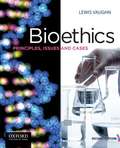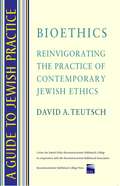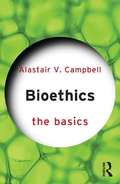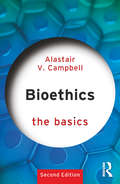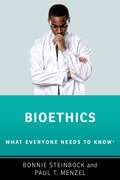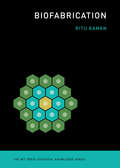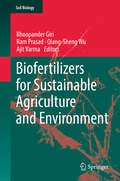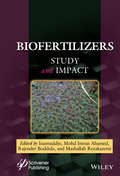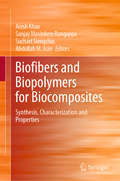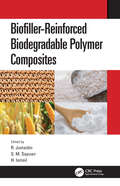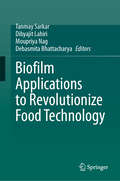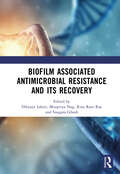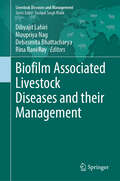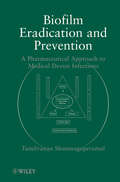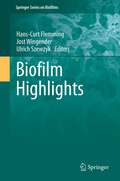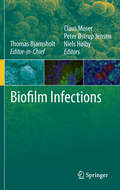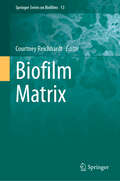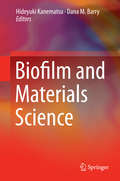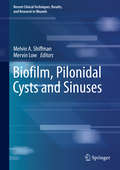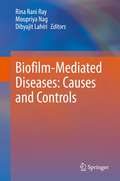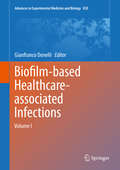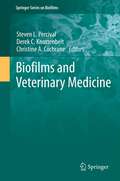- Table View
- List View
Bioethics: Principles, Issues, and Cases, Second Edition
by Lewis VaughnBioethics: Principles, Issues, and Cases, Second Edition, explores the philosophical, medical, social, and legal aspects of key bioethical issues. Opening with a thorough introduction to ethics, bioethics, and moral reasoning, it then covers influential moral theories and the criteria for evaluating them. Integrating eighty-five readings - thirteen of them new to this edition - numerous cases, and abundant pedagogical tools, the book addresses the most provocative and controversial topics in bioethics. Updated throughout, the second edition incorporates new information on justice, health care, and health insurance reform along with more coverage of issues related to race and culture and of the moral challenges facing nurses and other health care professionals. It also offers additional step-by-step guidance on how to identify and evaluate moral arguments in real-world contexts, with accompanying exercises and answers in an appendix.
Bioethics: Reinvigorating the Practice of Contemporary Jewish Ethics
by David A. TeutschThis title approaches the contemporary issues of bioethics within the context of Jewish tradition. "A Guide to Jewish Practice: Bioethics" thoughtfully surveys the field of bioethics from a Jewish perspective and addresses a number of hot-button issues. Is euthanasia ever permissible? How should we make decisions on behalf of an incapacitated patient? When is abortion a valid ethical choice? And ultimately, is it only the individual patient who is responsible for maintaining health, or should society assume some of the burden? The book also contains an essay that explores the implications of values-based decision making.
Bioethics: The Basics
by Alastair V. CampbellBioethics: The Basics is an introduction to the foundational principles, theories and issues in the study of medical and biological ethics. Readers are introduced to bioethics from the ground up before being invited to consider some of the most controversial but important questions facing us today. Topics addressed include: The range of moral theories underpinning bioethics Arguments for the rights and wrongs of abortion, euthanasia and animal research Healthcare ethics including the nature of the practitioner-patient relationship Public policy ethics and the implications of global and public health Concise, readable and authoritative, this is the ideal primer for anyone interested in the study of bioethics.
Bioethics: The Basics (The Basics)
by Alastair V. CampbellBioethics: The Basics is an introduction to the foundational principles, theories and issues in the study of medical and biological ethics. Readers are introduced to bioethics from the ground up before being invited to consider some of the most controversial but important questions facing us today. Topics addressed include: the range of moral theories underpinning bioethics arguments for the rights and wrongs of abortion, euthanasia and animal research health care ethics including the nature of the practitioner-patient relationship public policy ethics and the implications of global and public health ‘3 parents’, enhancement, incidental findings and nudge approaches in health care. This thoroughly revised second edition provides a concise, readable and authoritative introduction for anyone interested in the study of bioethics.
Biofabrication (The MIT Press Essential Knowledge series)
by Ritu RamanHow engineered materials and machines powered by living biological cells can tackle technological challenges in medicine, agriculture, and global security.You are a biological machine whose movement is powered by skeletal muscle, just as a car is a machine whose movement is powered by an engine. If you can be built from the bottom up with biological materials, other machines can be as well. This is the conceptual starting point for biofabrication, the act of building with living cells--building with biology in the same way we build with synthetic materials. In this volume in the MIT Press Essential Knowledge series, Ritu Raman offers an accessible introduction to biofabrication, arguing that it can address some of our greatest technological challenges. After presenting the background information needed to understand the emergence and evolution of biofabrication and describing the fundamental technology that enables building with biology, Raman takes deep dives into four biofabrication applications that have the potential to affect our daily lives: tissue engineering, organs-on-a-chip, lab-grown meat and leather, and biohybrid machines. Organs-on-a-chip (devices composed of miniature model tissues), for example, could be used to test new medicine and therapies, and lab-grown meat could alleviate environmental damage done by animal farming. She shows that biological materials have abilities synthetic materials do not, including the ability to adapt dynamically to their environments. Exploring the principles of biofabrication, Raman tells us, should help us appreciate the beauty, adaptiveness, and persistence of the biological machinery that drives our bodies and our world.
Biofabrication for Orthopedics: Methods, Techniques and Applications
by Xin Zhao Wenguo Cui Shen LiuBiofabrication for Orthopedics A comprehensive overview of biofabrication techniques for orthopedics and their novel applications With an ever-increasing global population and the rise in the occurrence of orthopedic diseases amongst an aging population, it is essential for technological advances to meet this growing medical need. Orthopedic biofabrication is a cutting-edge field that seeks to produce novel clinical solutions to this mounting problem, through the incorporation of revolutionary technologies that have the potential to not only transform healthcare, but also provide highly automated and personalized patient solutions. With the advances in the discipline, there is a significant growing interest in biofabrication for orthopedics in research activity geared towards routine clinical use. Ideal for a broad readership amongst medical practitioners and scientists, Biofabrication for Orthopedics summarizes all aspects of the topic: detailed information on the technology, along with advanced developments, research progress, and future perspectives on biofabrication for orthopaedics—particularly on the potential applications for tissue engineering technologies. In doing so, the book describes the various biomaterials—natural and synthetic—use for orthopedics and discusses the many ways in which these materials can be used in all parts of the body. As such, it offers detailed information on a wide range of applications in the fields of biology and clinical and industrial manufacturing. Biofabrication for Orthopedics readers will also find: Insights into the applications of biofabrication technologies in various bodily functions Thorough discussion of different biofabrication techniques used in creating orthopedic products, like stereolithography, cell sheet and organ bioprinting, electrospinning, and microfluidics Discussion of a wide range of diverse functions, such as bone implants, skin regeneration, vascularization, meniscus remodeling, and more Biofabrication for Orthopedics is a useful reference for those in a variety of research fields like medical-related practitioners and scientists, materials science, medicine, and manufacturing, as well as the libraries who support them.
Biofeedback and Mindfulness in Everyday Life: Practical Solutions For Improving Your Health And Performance
by Inna KhazanA mind-body approach to taking control of your physical and emotional health. Biofeedback is the process of training your body to control its involuntary actions, such as breathing and heart rate. Minor changes to these actions can significantly improve physical and emotional well- being. In Biofeedback and Mindfulness in Everyday Life, Harvard Medical School faculty member Inna Khazan pairs biofeedback techniques with mindfulness practice to address some of life’s most common ailments— from anxiety and fear to stress and insomnia. She begins with a description of basic physiological information, explaining concepts such as breathing and overbreathing. In Part Two she dives into the practice of mindfulness. And in Part Three she zeroes in on applying this mind-body approach to an array of common problems. Khazan’s approach outlines simple solutions for readers who want to improve the way they respond to challenges. She guides them through increasing their resilience and emotional flexibility while empowering them to take back control of their overall health.
Biofertilizers for Sustainable Agriculture and Environment (Soil Biology #55)
by Ajit Varma Ram Prasad Qiang-Sheng Wu Bhoopander GiriThis book provides a comprehensive overview of the benefits of biofertilizers as an alternative to chemical fertilizers and pesticides.Agricultural production has increased massively over the last century due to increased use of chemical fertilizers and pesticides, but these gains have come at a price. The chemicals are not only expensive; they also reduce microbial activity in agricultural soils and accumulate in the food chain, with potentially harmful effects for humans. Accordingly, it is high time to explore alternatives and to find solutions to overcome our increasing dependence on these chemicals.Biofertilizers, which consist of plant remains, organic matter and microorganisms, might offer an alternative. They are natural, organic, biodegradable, eco-friendly and cost-effective. Further, the microbes present in the biofertilizers are important, because they produce nutrients required for plant growth (e.g., nitrogen, phosphorus, potassium), as well as substances essential for plant growth and development (e.g., auxins and cytokinins). Biofertilizers also improve the physical properties, fertility and productivity of soil, reducing the need for chemical fertilizers while maintaining high crop yield. This makes biofertilizers a powerful tool for sustainable agriculture and a sustainable environment.The book covers the latest research on biofertilizers, ranging from beneficial fungal, bacterial and algal inoculants; to microbes for bioremediation, wastewater treatment; and recycling of biodegradable municipal, agricultural and industrial waste; as well as biocontrol agents and bio-pesticides. As such, it offers a valuable resource for researchers, academics and students in the broad fields of microbiology and agriculture.
Biofertilizers for Sustainable Soil Management
by Shah Fahad Muhammad Adnan Shah Saud Fazli WahidThe alkaline calcareous nature, high pH, salinity, heavy metals pollution, and low organic matter content of soils in many parts of the world have diminished the soil fertility and made essential nutrients unavailable to crops. To cope with the poor availability of soil nutrients, improve soil health, and feed the fast-growing global population, the farming community is using millions of tons of expensive chemical fertilizers in their fields to maintain an adequate level of nutrients for crop sustainability as well as to ensure food security. In this scenario, the exploitation of biofertilizers has become of paramount importance in the agricultural sector for their potential role in food safety and sustainable crop production. Bearing in mind the key importance of biofertilizers, this book examines the role of biofertilizers in sustainable management of soil and plant health under different conditions of the changing climate. Finally, it provides a platform for scientists and academicians all over the world to promote, share, and discuss various new issues, developments, and limitations in biofertilizers, crops, and beneficial microbes. Salient Features: Mainly focuses on the role of biofertilizers in managing soils for improving crop and vegetable yields as a substitute for chemical fertilizers. Highlights the valuable information for the mechanism of action, factors affecting, and limitations of biofertilizers in the wider ecosystem. Presents a diversity of techniques used across plant science. Designed to cater to the needs of researchers, technologists, policy makers, and undergraduates and postgraduates studying in the fields of organic agriculture, soil microbiology, soil biology, soil fertility, and fertilizers. Addresses plant responses to biofertilizers.
Biofertilizers: Study and Impact
by Rajender Boddula Inamuddin, Mohd Imran Ahamed Mashallah RezakazemiGreat attention has been paid to reduce the use of conventional chemical fertilizers harming living beings through food chain supplements from the soil environment. Therefore, it is necessary to develop alternative sustainable fertilizers to enhance soil sustainability and agriculture productivity. Biofertilizers are the substance that contains microorganisms (bacteria, algae, and fungi) living or latent cells that can enrich the soil quality with nitrogen, phosphorous, potassium, organic matter, etc. They are a cost-effective, biodegradable, and renewable source of plant nutrients/supplements to improve the soil-health properties. Biofertilizers emerge as an attractive alternative to chemical fertilizers, and as a promising cost-effective technology for eco-friendly agriculture and a sustainable environment that holds microorganisms which enhance the soil nutrients’ solubility leading a raise in its fertility, stimulates crop growth and healthy food safety. This book provides in-depth knowledge about history and fundamentals to advances biofertilizers, including latest reviews, challenges, and future perspectives. It covers fabrication approaches, and various types of biofertilizers and their applications in agriculture, environment, forestry and industrial sectors. Also, organic farming, quality control, quality assurance, food safety and case-studies of biofertilizers are briefly discussed. Biofertilizers' physical properties, affecting factors, impact, and industry profiles in the market are well addressed. This book is an essential guide for farmers, agrochemists, environmental engineers, scientists, students, and faculty who would like to understand the science behind the sustainable fertilizers, soil chemistry and agroecology.
Biofibers and Biopolymers for Biocomposites: Synthesis, Characterization and Properties
by Abdullah M. Asiri Anish Khan Suchart Siengchin Sanjay Mavinkere RangappaThis book summarizes recent developments in epoxy blends. It emphasizes new challenges for the synthesis, characterization, and properties of biofibers and biopolymers. It provides updates on all the important areas of biofibers and biopolymers in a comprehensive fashion, including synthesis, processing, characterisation and application. It provides a a one-stop reference for researchers and those working in industry and government. The book correlates macro, micro and nanostructure properties. Moreover, it provides cutting edge research from experts around the globe. The current status, trends, future directions and opportunities are discussed in detail, making the book also accessible for beginners to the subject and young researchers.
Biofiller-Reinforced Biodegradable Polymer Composites
by R. JumaidinPresenting a comprehensive overview of the field, Biofiller-Reinforced Biodegradable Polymer Composites examines biodegradable composites derived from biofiller and biodegradable polymers while providing critical information for efficient use of biocomposites developed from natural resources. Discusses advanced techniques for the use of both biofiller and biodegradable polymers as the matrix for composites. Highlights application of both natural fiber and natural matrix for composites in the development of environmentally friendly and sustainable materials. Introduces the basics of biocomposites, the processing and characteristics of new composite materials, and new combinations of composites such as soy protein and nanocellulose. Elaborates on the introduction of new materials to develop biodegradable polymers. This book has been written for researchers, advanced students, and professional engineers and materials scientists working in the area of bio-based polymers, natural fiber composites, and biocomposites.
Biofilm Applications to Revolutionize Food Technology
by Moupriya Nag Dibyajit Lahiri Tanmay Sarkar Debasmita BhattacharyaBiofilm Applications to Transform the Food Industry is a sweeping introduction to the world of biofilms, illuminating their potential to revolutionize the landscape of both food safety and culinary innovation. This groundbreaking work delves into the various methods through which biofilms improve quality and sensory aspects, while also enhancing overall safety and sustainability. At its core, this book addresses the preeminent challenge facing the food industry: how to optimize taste, enhance safety and extend shelf life without compromising nutritional value. It offers a dynamic blueprint for chefs, food scientists, and industry professionals to leverage biofilm usage, exploring cutting-edge techniques that revolutionize fermentation, flavor enhancement, and waste reduction. By decoding the intricate mechanisms of biofilm interactions, this work unveils solutions to persistent industry challenges, providing practical insights and strategies to elevate culinary experiences while meeting consumer demands for healthier, safer, and more flavorful foods. Biofilm Applications to Transform the Food Industry is an indispensable guide for culinary professionals, food technologists, and enthusiasts seeking to stay ahead in a rapidly evolving industry. It equips readers with the tools to navigate the complexities of biofilm applications, empowering them to innovate, create ethically sound products, and contribute to a more sustainable future. This title's relevance lies in its ability to bridge the gap between cutting-edge science and practical culinary applications, making it an essential resource for those passionate about shaping the future of food technology.
Biofilm Associated Antimicrobial Resistance and Its Recovery
by Rina Rani Ray Moupriya Nag Dibyajit Lahiri Sougata GhoshA biofilm is a collection of microbial cells that have adhered to biotic surfaces such as plant cuticles or animal epithelia, as well as abiotic surfaces such as rocky substratum or catheter exteriors. The life cycle of a microorganism includes the fundamental process of biofilm formation for survival in diverse and harsh environments since it is a protected mode of growth allowing colonisation of new habitats by dispersal of microbes from the microbial clusters. The biofilm bound microorganisms remain embedded in an extracellular polymeric matrix that protects the indwelling cells from surfactants, biocides, several invaders like protozoans, and defences offered by the hosts like phagocytic cells. The biofilm bound recalcitrant microbes induce chronic and nosocomial diseases, posing a serious threat to public health. It has been observed that various antimicrobial drugs are able to successfully remove the planktonic (freely suspended) states of microbes as compared to the sessile (substrate-bound) forms, thus resulting in the development of antimicrobial resistance. Modern pharmacological strategies targeting the biofilm matrix differ from the conventional methods of antibiotic usage. This includes the use of natural compounds such as plant bioactive molecules, antimicrobial peptides, green synthesised nanoparticles, or secondary metabolites from other organisms that not only prevent the rise of antimicrobial resistance but are also safe for the host tissues. Biofilm Associated Antimicrobial Resistance and Its Recovery provides a detailed and systematic review of alternative pharmacological developments in the field of biofilm research. Features: A narrative overview of the mechanism of biofilm formation and its role in the emergence of antimicrobial resistance. Recent research in the development of antibiofilm remedies involving biogenic compounds. Advancements in biofilm detection methodologies with cutting-edge technologies. This book serves as a resource for researchers who need to understand and analyze the progression of events during microbial biofilm formation, as well as design safer methodologies for its successful eradication. It may also be used as a textbook for a graduate level course in microbiology or microbial biotechnology.
Biofilm Associated Livestock Diseases and their Management (Livestock Diseases and Management)
by Rina Rani Ray Moupriya Nag Dibyajit Lahiri Debasmita BhattacharyaThe book discusses biofilms and adherent communities of microorganisms that play a significant role in livestock-associated infections. It explores the characteristics, formation, and consequences of biofilms in various livestock species and explains their involvement in diseases like mastitis, Johne's disease, caseous lymphadenitis, and more. It also explains intricate aspects of biofilm-related challenges, such as virulence, antibiotic resistance, quorum sensing, and inter-species communication. The book then explores the strategies for combatting biofilm-associated infections, encompassing phytomedicines, novel antimicrobials, and nanomedicines. This book serves as a great resource for researchers, veterinary practitioners and students by addressing these critical issues and providing a comprehensive understanding of biofilm dynamics in livestock infections, fostering improved diagnosis and treatment methodologies.
Biofilm Eradication and Prevention
by Tamilvanan ShunmugaperumalBiofilm Eradication and Preventions presents the basics of biofilm formation on medical devices, diseases related to this formation, and approaches pharmaceutical researchers need to take to limit this problem. Split into three parts, the first deals with the development and characterization of biofilm on the surfaces of implanted or inserted medical devices. Questions as to why biofilms form over medical device surfaces and what triggers biofilm formation are addressed. In the second section, the author discusses biofilm-mediated chronic infections occurred in various organs (eyes, mouth, wounds) and pharmaceutical and drug delivery knowledge gained from research in these area. The third part explores pharmaceutical approaches like lipid-and polymer-based drug delivery carriers for eradicating biofilm on device-related infections. In addition, this section also explores the topic of novel small molecule (like iron and its complexes/metal chelators) and a quorum-sensing inhibitors to control medical biofilm formation.
Biofilm Highlights (Springer Series on Biofilms #5)
by Hans-Curt Flemming Jost Wingender Ulrich SzewzykLiving in biofilms is the common way of life of microorganisms, transiently immobilized in their matrix of extracellular polymeric substances (EPS), interacting in many ways and using the matrix as an external digestion and protection system. This is how they have organized their life in the environment, in the medical context and in technical systems - and has helped make them the oldest, most successful and ubiquitous form of life. In this book, hot spots in current biofilm research are presented in critical and sometimes provocative chapters. This serves a twofold purpose: to provide an overview and to inspire further discussions. Above all, the book seeks to stimulate lateral thinking.
Biofilm Infections
by Claus Moser Thomas Bjarnsholt Niels Høiby Peter Østrup JensenThis book will cover both the evidence for biofilms in many chronic bacterial infections as well as the problems facing these infections such as diagnostics and treatment regimes. A still increasing interest and emphasis on the sessile bacterial lifestyle biofilms has been seen since it was realized that that less than 0.1% of the total microbial biomass lives in the planktonic mode of growth. The term was coined in 1978 by Costerton et al. who defined the term biofilm for the first time.In 1993 the American Society for Microbiology (ASM) recognised that the biofilmmode of growth was relevant to microbiology. Lately many articles have been published on the clinical implications of bacterial biofilms. Both original articles and reviews concerning the biofilm problem are available.
Biofilm Matrix (Springer Series on Biofilms #13)
by Courtney ReichhardtThis book provides a comprehensive review of biofilm matrices. The main topics include an introduction to biofilm matrices and the range of biofilm matrix components (i.e., biofilm matrixome) as well as an overview of what is known about matrix structure, functionality, and regulation. Additional topics include recent progress in investigating the biofilm matrixome as well as challenges and outstanding questions and descriptions of the influence of matrix interactions on biofilm architecture and pathogen-host interactions. This book covers an important aspect of biofilm biology-microbial biofilm matrices. Microbes form multicellular aggregates called biofilms, in which microbial cells are encased in an extracellular matrix. This enables microbes to withstand harsh environmental conditions including antibiotic treatment. Biofilms are ubiquitous in the environment and can be both beneficial and harmful. For example, they can be used to clean up wastewater, but they also cause serious and chronic infections. It is estimated that over 80% of infections in the United States are biofilm-associated. Some examples of biofilm-involved infections include infections of implanted medical devices or artificial joints and also chronic infections of burns and wounds, including diabetic ulcers. When biofilms show up during infections or human health problems, they act very differently than planktonic bacteria. For example, biofilms can be ~1000-fold more tolerant of antibiotics than their planktonic counterparts. The biofilm matrix is thought to be a key part of why these bacterial infections are so difficult to treat. Biofilm matrix composition varies between bacterial strains and under different growth conditions. In general, the biofilm matrix is rich in biopolymers and can contain exopolysaccharides, proteins, extracellular DNA (or eDNA), and lipids. The biofilm matrix promotes attachment and structurally reinforces bacterial aggregates, preventing clearance by mechanical forces. The matrix can even block antibiotics from accessing the bacteria or prevent the host immune system from seeing the bacteria. The target audience of this book is both established biofilm researchers and those who are newly learning about biofilms and biofilm matrices.
Biofilm and Materials Science
by Hideyuki Kanematsu Dana M. BarryThis book explains the formation of biofilm on materials surfaces in an industrial setting. The authors describe new developments in understanding of biofilm formation, detection, and control from the viewpoint of materials science and engineering. The book details the range of issues caused by biofilm formation and the variety of affected industries.
Biofilm, Pilonidal Cysts and Sinuses (Recent Clinical Techniques, Results, and Research in Wounds #1)
by Melvin A. Shiffman Mervin LowThis book discusses the latest findings in the fields of biofilm, pilonidal cysts and sinuses. The first part provides detailed information on biofilm formation, antibiofilm properties and activity as well as their potential clinical application in wound management. The second part then examines pilonidal sinus disease and the surgical treatment options. Written by leading experts in the field, the book is a valuable resource for beginners and experienced surgeons alike.
Biofilm-Mediated Diseases: Causes and Controls
by Rina Rani Ray Moupriya Nag Dibyajit LahiriThis book reviews the current concepts in biofilm formation and its implications in human health and disease. The initial chapters introduce the mechanisms of biofilm formation and its composition. Subsequently, the chapters discuss the role of biofilm in acute and chronic infections. It also explores the pivotal role of both innate and adaptive immunity on the course of biofilm infection. In addition, the book elucidates the bacterial biofilm formation on implantable devices and the current approaches to its treatment and prevention. It analyzes the possible relationship between antimicrobial resistance and biofilm formation. Finally, the book also summarizes the current state-of-the-art therapeutic approaches for preventing and treating biofilms. This book is a useful resource for researchers in the field of microbiology, clinical microbiology, and also medical practitioners.
Biofilm-based Healthcare-associated Infections: Volume I (Advances in Experimental Medicine and Biology #830)
by Gianfranco DonelliThe aim of this book is to provide readers with a wide overview of the main healthcare-associated infections caused by bacteria and fungi able to grow as biofilm. The recently acquired knowledge on the pivotal role played by biofilm-growing microorganisms in healthcare-related infections has given a new dynamic to detection, prevention and treatment of these infections in patients admitted to both acute care hospitals and long-term care facilities. Clinicians, hygienists and microbiologists will be updated by leading scientists on the state-of-art of biofilm-based infections and on the most innovative strategies for prevention and treatment of these infections, often caused by emerging multidrug-resistant biofilm-growing microorganisms.
Biofilms and Veterinary Medicine (Springer Series on Biofilms #6)
by Steven L. Percival Derek C. Knottenbelt Christine A. CochraneBiofilms are implicated in many common medical problems including urinary tract infections, catheter infections, middle-ear infections, dental plaque, gingivitis, and some less common but more lethal processes such as endocarditis and infections in cystic fibrosis. However, the true importance of biofilms in the overall process of disease pathogenesis has only recently been recognized. Bacterial biofilms are one of the fundamental reasons for incipient wound healing failure in that they may impair natural cutaneous wound healing and reduce topical antimicrobial efficiency in infected skin wounds. Their existence explains many of the enigmas of microbial infection and a better grasp of the process may well serve to establish a different approach to infection control and management. Biofilms and their associated complications have been found to be involved in up to 80% of all infections. A large number of studies targeted at the bacterial biofilms have been conducted, and many of them are referred to in this book, which is the first of its kind. These clinical observations emphasize the importance of biofilm formation to both superficial and systemic infections, and the inability of current antimicrobial therapies to 'cure' the resulting diseases even when the in vitro tests suggest that they should be fully effective. In veterinary medicine the concept of biofilms and their role in the pathogenesis of disease has lagged seriously behind that in human medicine. This is all the more extraordinary when one considers that much of the research has been carried out using veterinary species in experimental situations. The clinical features of biofilms in human medicine is certainly mimicked in the veterinary species but there is an inherent and highly regrettable indifference to the failure of antimicrobial therapy in many veterinary disease situations, and this is probably at its most retrograde in veterinary wound management. Biofilms and Veterinary Medicine is specifically focused on discussing the concerns of biofilms to health and disease in animals and provides a definitive text for veterinary practitioners, medical and veterinary students, and researchers.
